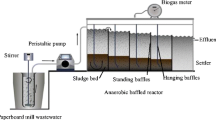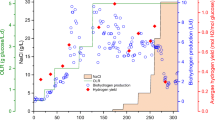Abstract
The water hyacinth, Eichhornia crassipes, impacts the environment in a number of ways. This study develops a continuous cultivation strategy and investigates the effect of these strategies for hydrogen production in anaerobic sequencing batch reactor (ASBR) and intermittent-continuous stirred tank reactor (I-CSTR) systems using the water hyacinth as feedstock. Glucose (10 g/L) was used as the feedstock to start-up the fermentor using pig slurry seed in a batch model. ASBR with increasing water hyacinth concentration was used as the start-up strategy for hydrogen production. However, the hydrogen performance decreased with increasing water hyacinth concentration. Finally, the metabolic pathway shifted to methane production with no hydrogen. A strategy for controlling the substrate and reaction pH and shortening the hydraulic retention time (HRT) in I-CSTR was used to enhance the hydrogen production. Low hydrogen production performance was achieved with a hydrogen production rate of 1.1 with 82.4mL/L-d methane production rate resulting from the I-CSTR operated using pH 4.0 feedstock and HRT 2days.
Similar content being viewed by others
References
Logan B.E., Rabaey K.: Conversion of wastes into bioelectricity and chemicals by using microbial electrochemical technologies. Science 337(6095), 686–690 (2012)
Lin C.Y., Lay C.H., Sen B., Chu C.Y., Kumar G., Chen C.C., Chang J.S.: Fermentative hydrogen production from wastewaters: a review and prognosis. Int. J. Hydrogen Energy 37(2), 15632–15642 (2012)
Chuang Y., Chen C., Lay C., Sung I., Wu J., Lee S., Sen B., Lin C.: Optimization of incubation factors for fermentative hydrogen production from agricultural wastes. Sustain. Environ. Res. 22(2), 99–106 (2012)
Lin C.Y., Hung W.C.: Enhancement of fermentative hydrogen/ethanol production from cellulose using mixed culture. Int. J. Hydrogen Energy 33, 3660–3667 (2008)
Lay C.H., Chang F.Y., Chu C.Y., Chen C.C., Chi Y.C., Hsieh T.T., Huang H.H., Lin C.Y.: Enhancement of anaerobic biohydrogen/methane production from cellulose using heat-treated activated sludge. Water Sci. Technol. 63, 1849–1854 (2011)
Wu X., Zhu J., Dong C., Miller C., Li Y., Wang L., Yao W.: Continuous biohydrogen production from liquid swine manure supplemented with glucose using an anaerobic sequencing batch reactor. Int. J. Hydrogen Energy 34(16), 6636–6645 (2009)
Reungsang, A.; Sittijunda, S.; O-Thong, S.: Biohydrogen production from glycerol by anaerobic mixed cultures. In: The 2010 Asian Bio-hydrogen symposium and APEC advanced bio-hydrogen technology conference. Feng Chia University, Taichung, Taiwan (2010)
Tenca A., Schievano A., Perazzolo F., Adani F., Oberti R.: Biohydrogen from thermophilic co-fermentation of swine manure with fruit and vegetable waste: maximizing stable production without pH control. Bioresour. Technol. 102(18), 8582–8588 (2011)
Li S.L., Kuo S.C., Lin J.S., Lee Z.K., Wang Y.H., Cheng S.S.: Process performance evaluation of intermittent—continuous stirred tank reactor for anaerobic hydrogen fermentation with kitchen waste. Int. J. Hydrogen Energy 33(5), 1522–1531 (2008)
Li S.L., Lin J.S., Wang Y.H., Lee Z.K., Kuo S.C., Tseng I.C., Cheng S.S.: Strategy of controlling the volumetric loading rate to promote hydrogen-production performance in a mesophilic-kitchen-waste fermentor and the microbial ecology analyses. Bioresour. Technol. 102(18), 8682–8687 (2011)
Wang Y.H., Li S.L., Chen I.C., Tseng I.C., Cheng S.S.: A study of the process control and hydrolytic characteristics in a thermophilic hydrogen fermentor fed with starch-rich kitchen waste by using molecular-biological methods and amylase assay. Int. J. Hydrogen Energy 35(23), 13004–13012 (2010)
Lee Z.K., Li S.L., Kuo P.C., Chen I.C., Tien Y.M., Huang Y.J., Chuang C.P., Wong S.C., Cheng S.S.: Thermophilic bio-energy process study on hydrogen fermentation with vegetable kitchen waste. Int. J. Hydrogen Energy 35(24), 13458–13466 (2010)
Chuang Y.S., Lay C.H., Sen B., Chen C.C., Gopalakrishnan K., Wu J.H., Lin C.S., Lin C.Y.: Biohydrogen and biomethane from water hyacinth (Eichhornia crassipes) fermentation: effects of substrate concentration and incubation temperature. Int. J. Hydrogen Energy 36(21), 14195–14203 (2011)
APHA: Standard methods for the examination of water and wastewater. American Public Health Association, New York (1995)
Koehler L.: Differentiation of carbohydrates by anthrone reaction rate and color intensity. Anal. Chem. 24, 1576–1579 (1952)
Ivanova G., Rákhely G., Kovács K.L.: Thermophilic biohydrogen production from energy plants by Caldicellulosiruptor saccharolyticus and comparison with related studies. Int. J. Hydrogen Energy 34, 3659–3670 (2009)
Lay C.H., Wu J.H., Hsiao C.L., Chang J.J., Chen C.C., Lin C.Y.: Biohydrogen production from soluble condensed molasses fermentation using anaerobic fermentation. Int. J. Hydrogen Energy 35, 13445–13451 (2010)
Koskinen P.E.P.: The development and microbiology of bioprocesses for the production of hydrogen and ethanol by dark fermentation. Tampere University of Technology, Tampere (2008)
Cheng J., **e B., Zhou J., Song W., Cen K.: Cogeneration of H2 and CH4 from water hyacinth by two-step anaerobic fermentation. Int. J. Hydrogen Energy 35(7), 3029–3035 (2010)
Dong L., Zhenhong Y., Yongming S., **aoying K., Yu Z.: Hydrogen production characteristics of the organic fraction of municipal solid wastes by anaerobic mixed culture fermentation. Int. J. Hydrogen Energy 34(2), 812–820 (2009)
Lay C.H., Sen B., Chen C.C., Wu J.H., Lee S.C., Lin C.Y.: Co-fermentation of water hyacinth and beverage wastewater in powder and pellet form for hydrogen production. Bioresour. Technol. 135, 610–615 (2013)
Author information
Authors and Affiliations
Corresponding author
Rights and permissions
About this article
Cite this article
Lay, CH., Sen, B., Chen, CC. et al. Continuous anaerobic hydrogen and methane production using water hyacinth feedstock. Arab J Sci Eng 41, 2563–2571 (2016). https://doi.org/10.1007/s13369-016-2035-4
Received:
Accepted:
Published:
Issue Date:
DOI: https://doi.org/10.1007/s13369-016-2035-4




